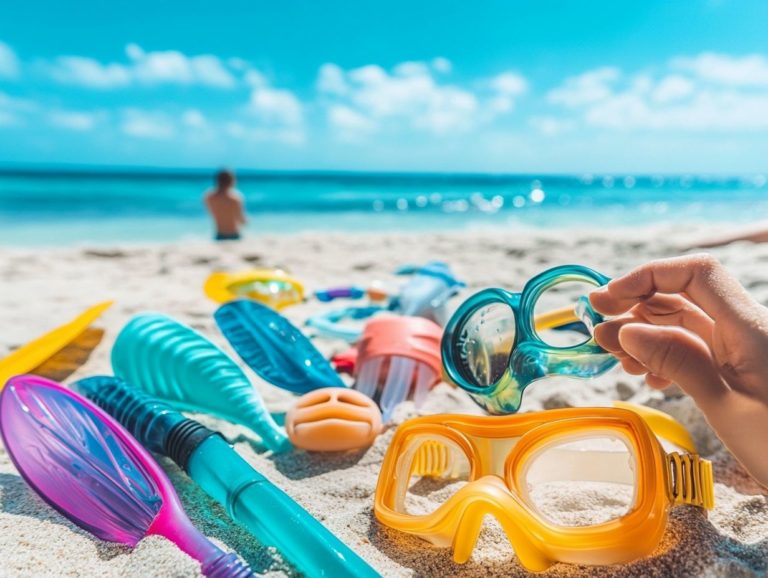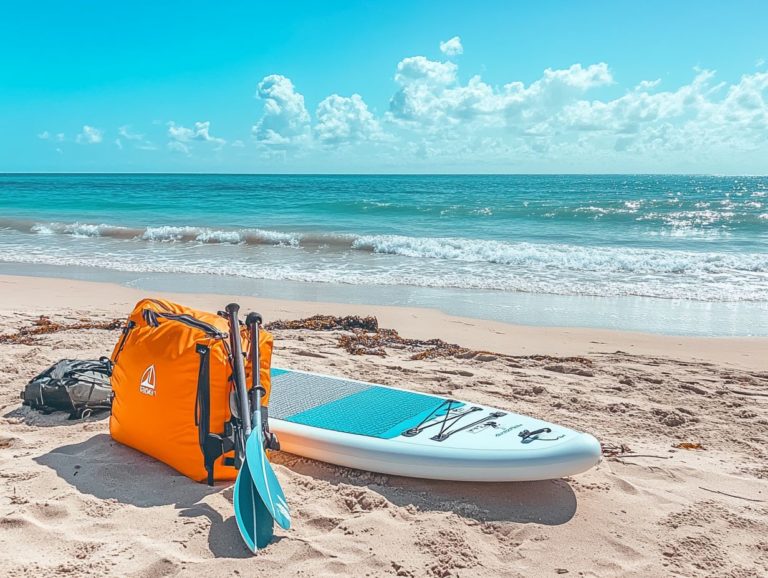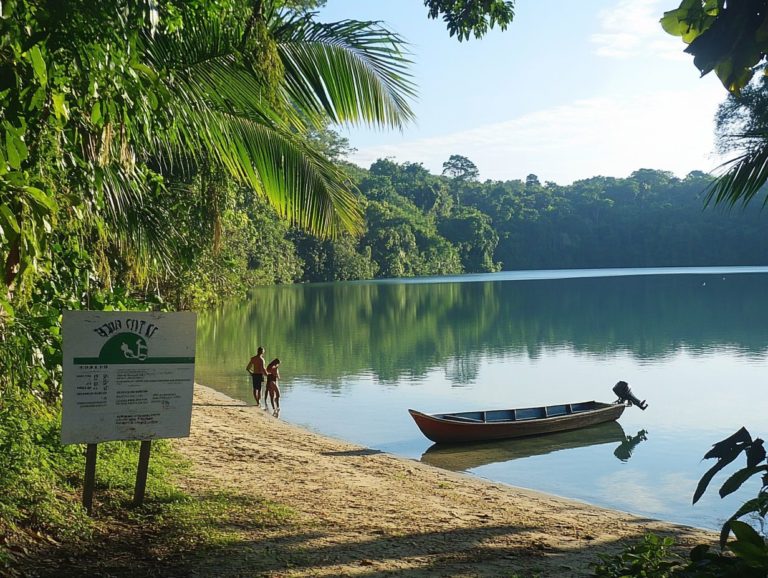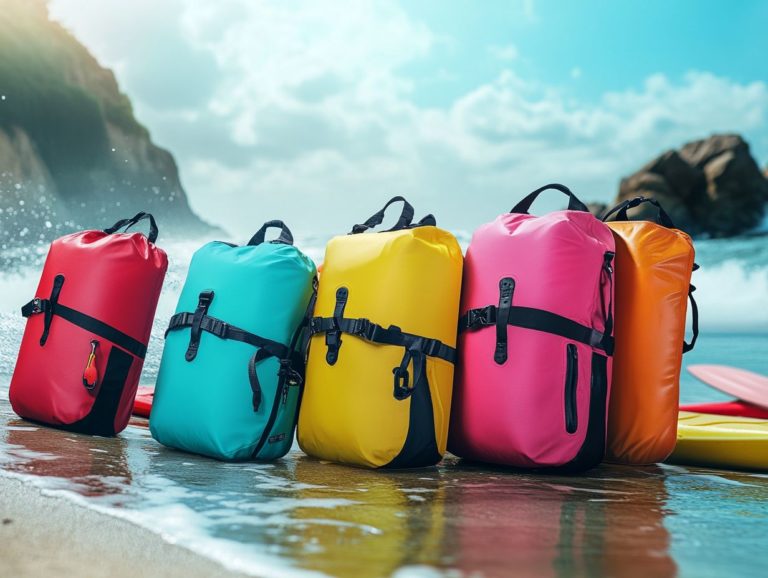Understanding the Gear Needed for Free Diving
Free diving unveils a captivating realm of underwater exploration, but equipping yourself with the right gear is paramount for both safety and enjoyment.
From the fundamentals, such as masks and snorkels, to optional accessories like underwater cameras, each piece of equipment serves a crucial function in elevating your experience. This guide presents both essential and optional gear for free diving, along with insightful tips on selecting and maintaining the right equipment.
Whether you re just starting out or considering an upgrade to your setup, you ll find a wealth of information to assist you on your thrilling journey into the depths!
Contents
Key Takeaways:
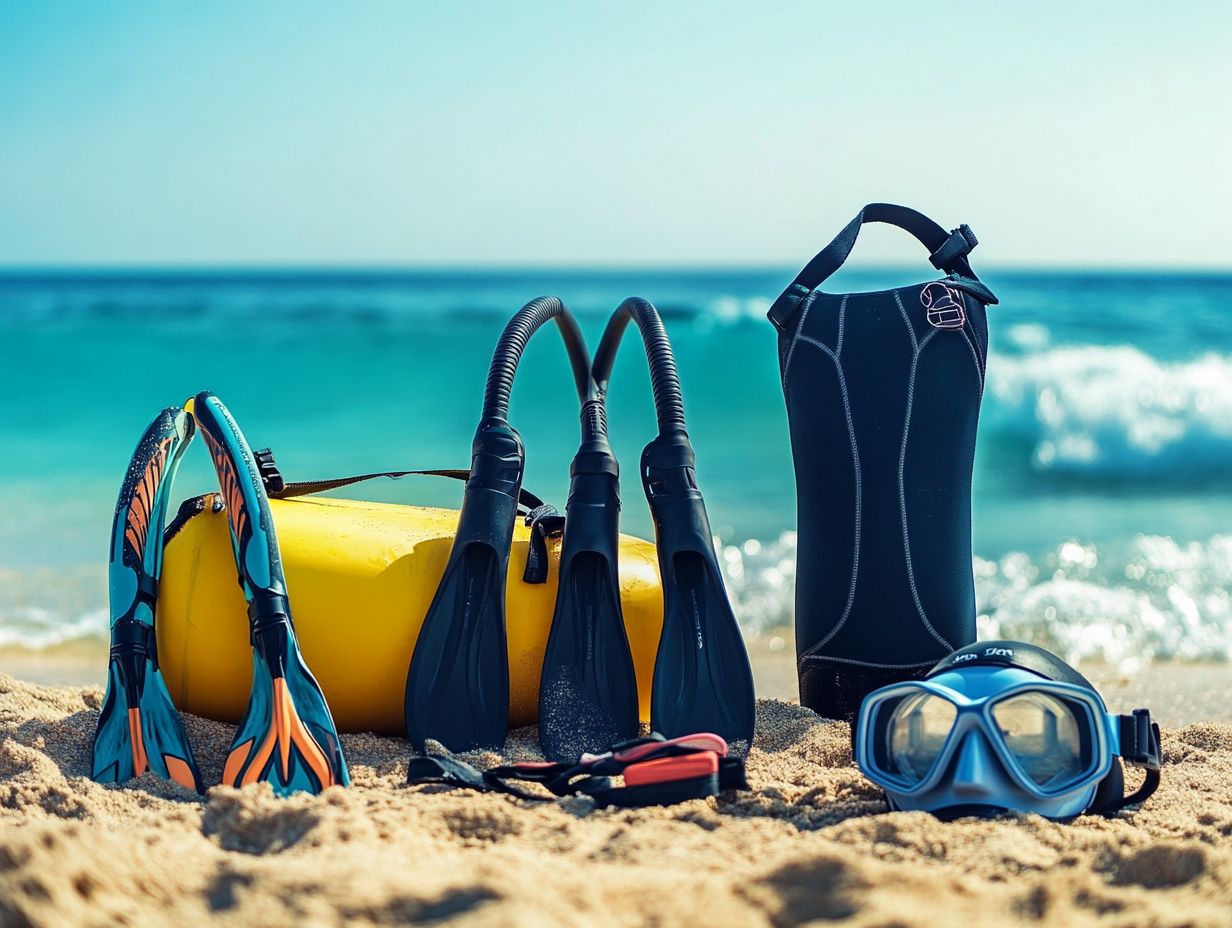
- Invest in essential gear like a mask, snorkel, wetsuit, fins, weights, and a knife to ensure your safety and comfort while free diving.
- Gear up with fun accessories like a dive computer, underwater camera, and float and line to enhance your experience and document your dives.
- When choosing gear, consider your skill level, diving location, and budget. Regularly maintain your equipment to ensure its effectiveness and longevity.
What is Free Diving Gear?
Free diving gear encompasses specialized equipment crafted to elevate your underwater experience, allowing you to explore the mesmerizing depths with both comfort and safety.
Essential items include a reliable dive watch for precise timekeeping, a sturdy dive bag for effortless storage, and an assortment of masks and fins. These items are important for ensuring an optimal free diving adventure.
Your choice of gear can profoundly influence your performance and enjoyment. Whether you’re gliding gracefully through the marine landscape with a mermaid tail or employing a weight belt to achieve enhanced buoyancy control, the right equipment makes all the difference.
Essential Gear for Free Diving
Essential gear for free diving is vital for maximizing your comfort, safety, and performance. It enables you to fully immerse yourself in the enchanting underwater world.
Key components include:
- Specially designed masks that enhance both comfort and visibility,
- Snorkels tailored to your preferences, and
- Fins that boost your propulsion through the water, like Hammerhead or Cressi fins.
A wetsuit also provides vital thermal protection, while a dive watch keeps you on track with time, ensuring your experience is as safe as it is enjoyable.
Mask and Snorkel
The mask and snorkel are essential components of your free diving gear, offering crucial visibility and ease of breathing as you explore breathtaking underwater landscapes. A low volume mask enhances your comfort and minimizes the air needed for equalization (the process of balancing pressure in your ears), while reliable brands like Cressi provide options that cater to various snorkel preferences.
When you find the perfect combination of mask and snorkel, it elevates your experience and ensures safety as you navigate the mesmerizing underwater world.
Choosing the right fit is vital; a well-fitting mask guarantees a secure seal, preventing water leakage and allowing for uninterrupted exploration. Many divers prefer low volume designs, such as the Cressi F1 or Mares X-Vision, for their ability to reduce drag and bring marine life into sharper focus.
When selecting a snorkel, consider factors like pipe diameter, flexibility, and dry top features to suit your comfort levels. Whether you lean towards a classic J-style snorkel or opt for a more advanced semi-dry version, customizing your gear based on your personal diving habits ultimately enhances your overall underwater adventure.
Get your gear ready and dive into adventure!
Wetsuit or Rash Guard
Choosing between a wetsuit and a rash guard is crucial for your comfort and thermal protection during freediving. The underwater environment can greatly impact your body temperature. A wetsuit delivers insulation, keeping you warm in cooler waters. In contrast, a rash guard provides lightweight UV protection in warmer climates. Each option has its merits, depending on the conditions you face and your personal preferences.
Wetsuits are typically crafted from thick neoprene and come in thicknesses ranging from 2mm to 7mm. This variety offers different levels of thermal insulation suitable for varying water temperatures. They excel in cooler environments, effectively shielding you from hypothermia.
On the other hand, rash guards are usually made from spandex or polyester. These materials allow for maximum breathability and flexibility, making them perfect for tropical settings. While they may not provide much thermal protection, they prevent rashes and skin irritations, enhancing your overall comfort.
Your choice between these two can significantly influence your safety and enjoyment underwater. This allows you to fully immerse yourself in the beauty beneath the waves without the distraction of discomfort or chill.
Fins
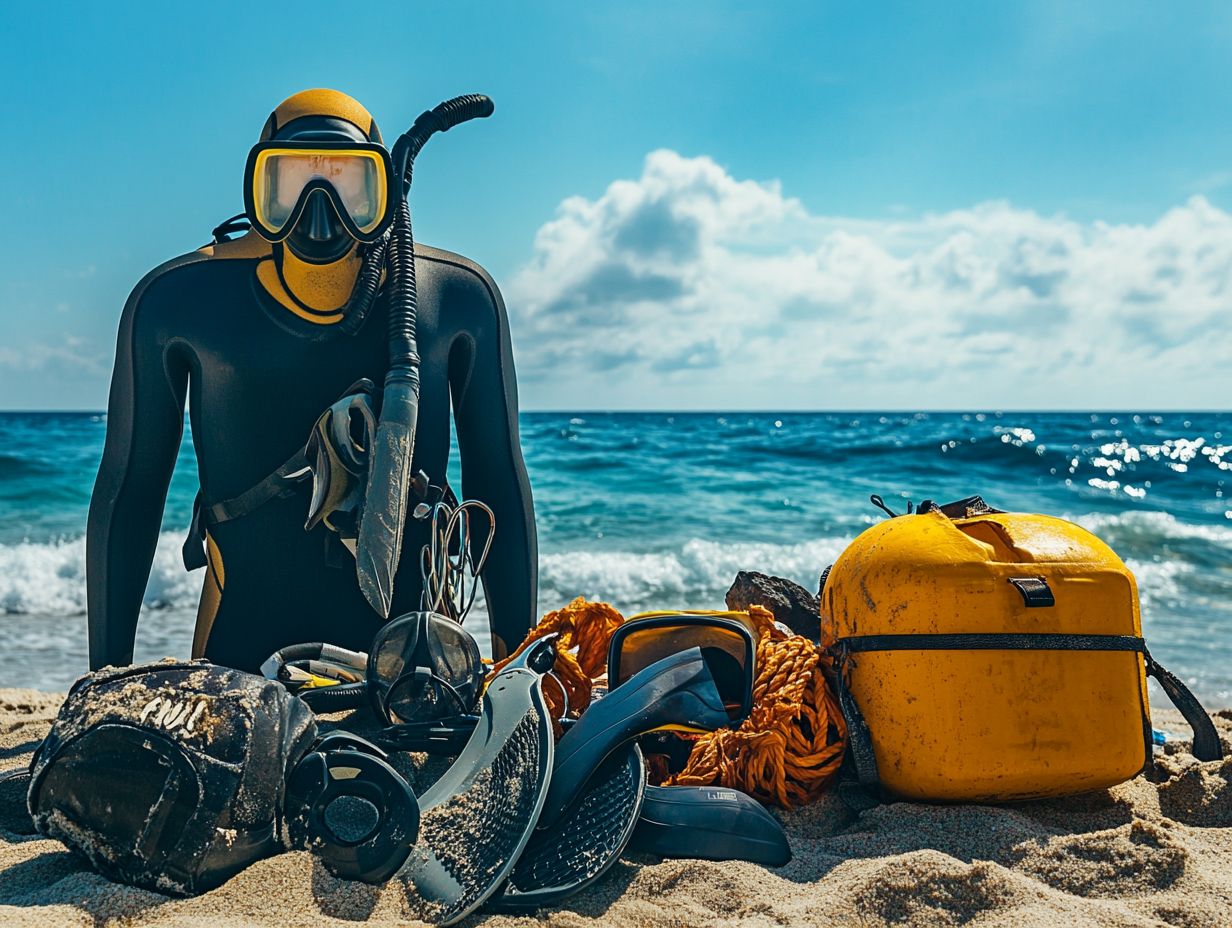
Freediving fins are essential for gliding effortlessly through the water. Your choice of fins can greatly influence your performance and training efficiency. Fins like Hammerhead are favored for their exceptional design and functionality. The shape of the fin is crucial for optimizing your movements and minimizing fatigue.
Selecting the right fins can elevate your entire diving experience, whether you re training or exploring new depths. You ll primarily encounter two types of freediving fins: full-foot and open-heel designs.
Full-foot fins fit snugly against your feet, providing a streamlined feel that many divers prefer. In contrast, open-heel fins come with adjustable straps, making them ideal for accommodating thicker boots on colder dives.
The shape and material of your fins especially if you opt for carbon fiber can greatly enhance your speed and comfort. Carbon fiber fins deliver exceptional energy transfer and flexibility, making them a top choice for experienced divers.
If you re just starting out, consider your diving style. A more relaxed approach might benefit from softer fins, while those who kick with intensity may prefer stiffer models to maximize propulsion. Choose wisely, and let your fins carry you to new underwater adventures!
Weights and Weight Belt
Weights and a weight belt are essential elements of your freediving gear. They offer the buoyancy control necessary for a safe and enjoyable diving experience. By evenly distributing weight around your waist, a weight belt helps maintain the proper body position underwater. This enables you to conserve energy and enhance your dive efficiency.
Choosing the right amount of weight is crucial for achieving optimal buoyancy and comfort during your dives. To find your ideal weight, consider your individual experience level, body composition, and the specific water conditions you’ll be diving in.
For example, experienced divers may require less weight than beginners. Beginners often benefit from added support to help with descent. Your body composition also matters; those with higher body fat may need less weight, while individuals with more muscle mass might require additional weight to reach neutral buoyancy.
Remember that freshwater and saltwater environments alter buoyancy dynamics. It s wise to adjust your weights accordingly. With a variety of weights and weight belts available on the market, designed for comfort and easy adjustments, understanding your options can significantly enhance your performance and overall enjoyment while diving.
Knife
A knife is a frequently overlooked yet essential piece of freediving gear, serving as a critical safety tool in emergency situations. Whether you need to cut away entanglements or handle unforeseen circumstances, a reliable knife boosts your confidence as you dive.
When selecting your freediving gear, it’s essential to consider the design, material, and ease of access of the knife. As you delve into the various types, you may find that blunt tip blades are ideal for safety, as they minimize the risk of accidental injury. Serrated edges provide superior cutting power, especially when you encounter thicker materials like fishing lines or nets.
A stainless steel composition is often a preferred choice due to its resistance to corrosion, while lighter alternatives like titanium can be appealing for their impressive strength-to-weight ratio.
Effective mounting options, such as sheaths or attachment points on your floating gear, can ensure that your knife is always within reach, reinforcing your overall safety strategy while diving.
Optional Gear for Freediving
Optional gear for freediving can greatly elevate your diving experience, offering enhanced safety and convenience tailored to your preferences and the specific conditions you encounter.
A dive computer, for instance, allows you to monitor depth and time with precision, while an underwater camera lets you immortalize the breathtaking beauty of the marine ecosystem.
Accessories like a dive float and dive lights improve visibility and safety during your dives, especially in low-light conditions.
Dive Computer
A dive computer is an essential piece of gear for your freediving adventures, providing crucial data such as depth, dive time, and safety alerts. Models like the Garmin Descent MK2S are crafted specifically for water sports, equipping you with real-time information that enhances both safety and performance.
This technology not only helps you monitor dive conditions but also allows you to track your progression over time. Beyond these essential features, a dive computer often boasts advanced functionalities like wave and current monitoring, which are invaluable for planning your optimal dive routes.
Safety features such as ascent rate warnings and multi-level dive tracking can significantly minimize the risk of accidents, making it a trustworthy companion beneath the waves.
When you compare different models, you ll likely appreciate the integration of Bluetooth connectivity, which simplifies data sharing and analysis, enriching your diving experience. These advancements not only make your underwater adventures more immersive but also empower you to make informed decisions while exploring the depths.
Underwater Camera
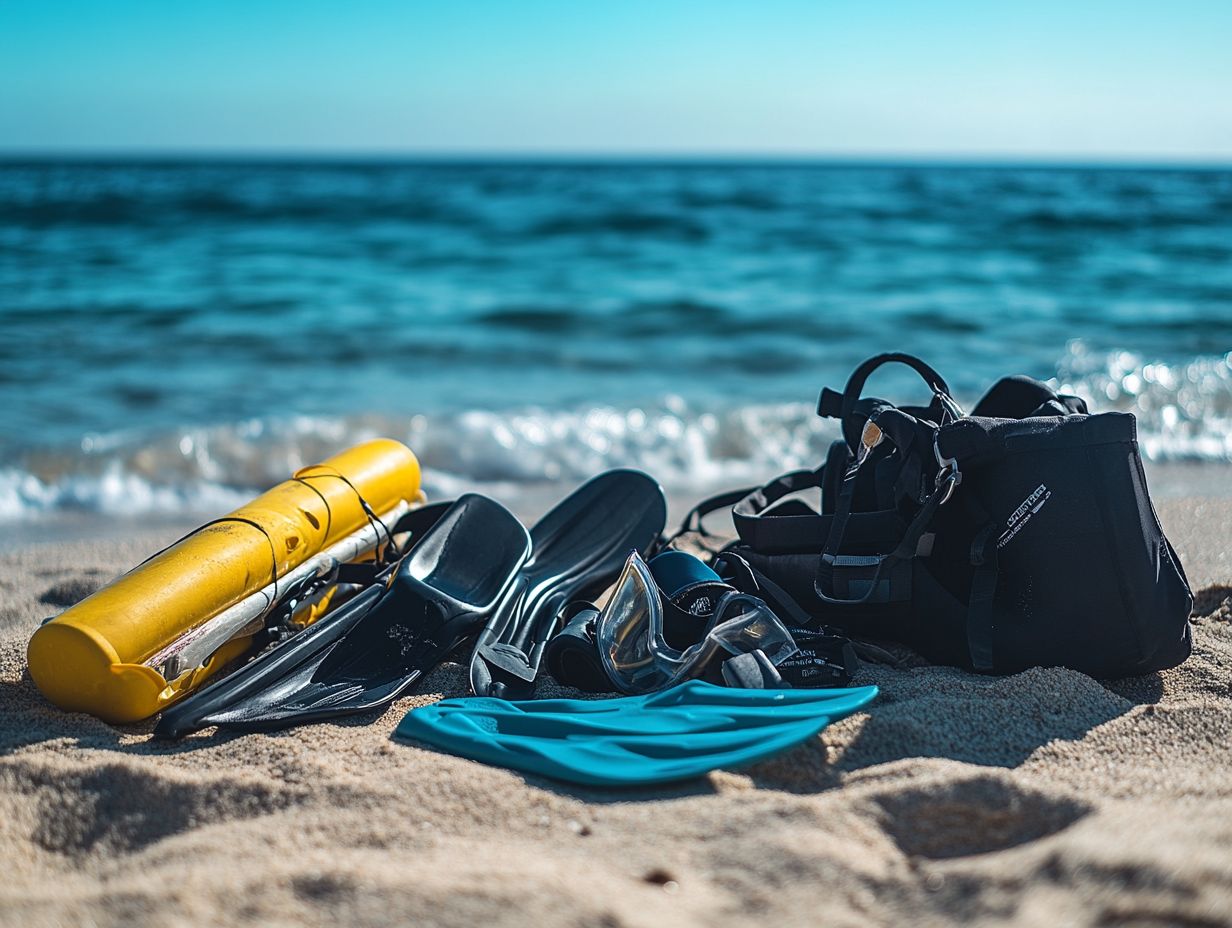
An underwater camera is an exceptional addition to your freediving gear, enabling you to capture breathtaking images of marine life and stunning underwater landscapes. Don’t miss out on capturing the underwater beauty! Whether for personal enjoyment or professional photography, the right camera can elevate your exploration experience significantly.
Modern underwater cameras are crafted specifically for water sports, making it easier than ever to obtain high-quality images. With a range of options from compact point-and-shoot models to sophisticated mirrorless systems, you have a wealth of choices tailored to your specific needs.
Look for features like waterproof ratings that withstand depths of up to 100 meters, outstanding low-light performance, and intuitive controls all of which provide versatility for various underwater conditions.
When selecting a camera, consider its user-friendliness, especially in challenging environments. To achieve optimal image quality, mastering techniques such as maintaining proper buoyancy, framing your subjects well, and harnessing natural light will elevate your photography to new heights.
By familiarizing yourself with the settings and practicing regularly, you can consistently capture mesmerizing shots that beautifully showcase the wonders of the aquatic world.
Float and Line
A dive float and line are essential for safety and organization while you’re freediving, especially in open water. The float helps you stay visible in the water, while the line provides a reliable reference point for depth and ascent.
Together, these tools enhance your safety and streamline navigation underwater. Using them minimizes the risk of accidents, such as collisions with boats or losing your sense of direction.
When selecting a dive float, prioritize features like visibility bright colors help with recognition from the surface. Ensure it offers stability and buoyancy in different conditions.
A durable line, made from high-quality, tangle-resistant material, should be long enough to accommodate your desired depths and reduce the risk of entanglement. By incorporating a dive float and line into your gear, you boost your safety and create a more enjoyable experience, allowing you to immerse yourself in the beauty around you.
Choosing the Right Gear for You
Selecting the right gear for freediving is crucial for achieving a comfortable fit, optimal performance, and an enjoyable experience during your underwater adventures.
With many options available, consider factors such as your personal comfort, the intended use, and specific performance requirements.
This thoughtful approach allows you to tailor your equipment choices to your unique needs and the specific environments you ll explore.
Factors to Consider
When selecting freediving gear, consider several key factors for optimal comfort and performance:
- Quality of materials
- Fit of the equipment
- Buoyancy, insulation, and ease of use
Understanding these elements can elevate your overall diving experience and safety. High-grade neoprene offers insulation and flexibility, allowing freedom of movement underwater.
The fit of your wetsuit or fins is crucial as well gear that feels too tight can limit mobility, while loose equipment may create drag.
Consider your diving style and the environments you explore, as they influence your gear choices. For example, if you re diving in colder waters, prioritize insulation, while speed-focused divers may prefer streamlined suits.
Reflecting on these aspects ensures your equipment aligns with your unique diving approach, enhancing both your enjoyment and safety.
Tips for Buying and Maintaining Gear
Buying and maintaining your freediving gear can extend its lifespan and elevate performance, ensuring a reliable and enjoyable diving experience.
When shopping for gear, choose trusted brands, read reviews, and try items for fit and comfort before deciding.
Regular maintenance, including cleaning and proper storage, is vital for keeping your equipment in top shape.
Rinse your gear with fresh water after each use to eliminate salt and debris that can cause deterioration. Before every dive, inspect your equipment for signs of wear or damage, focusing on seals and straps.
Store your gear in a cool, dry, shaded area to protect it from sunlight and heat. Consider using gear bags or cases designed for freediving equipment for extra protection.
It s also wise to schedule professional servicing for specialized parts to ensure everything remains safe and functional.
Frequently Asked Questions
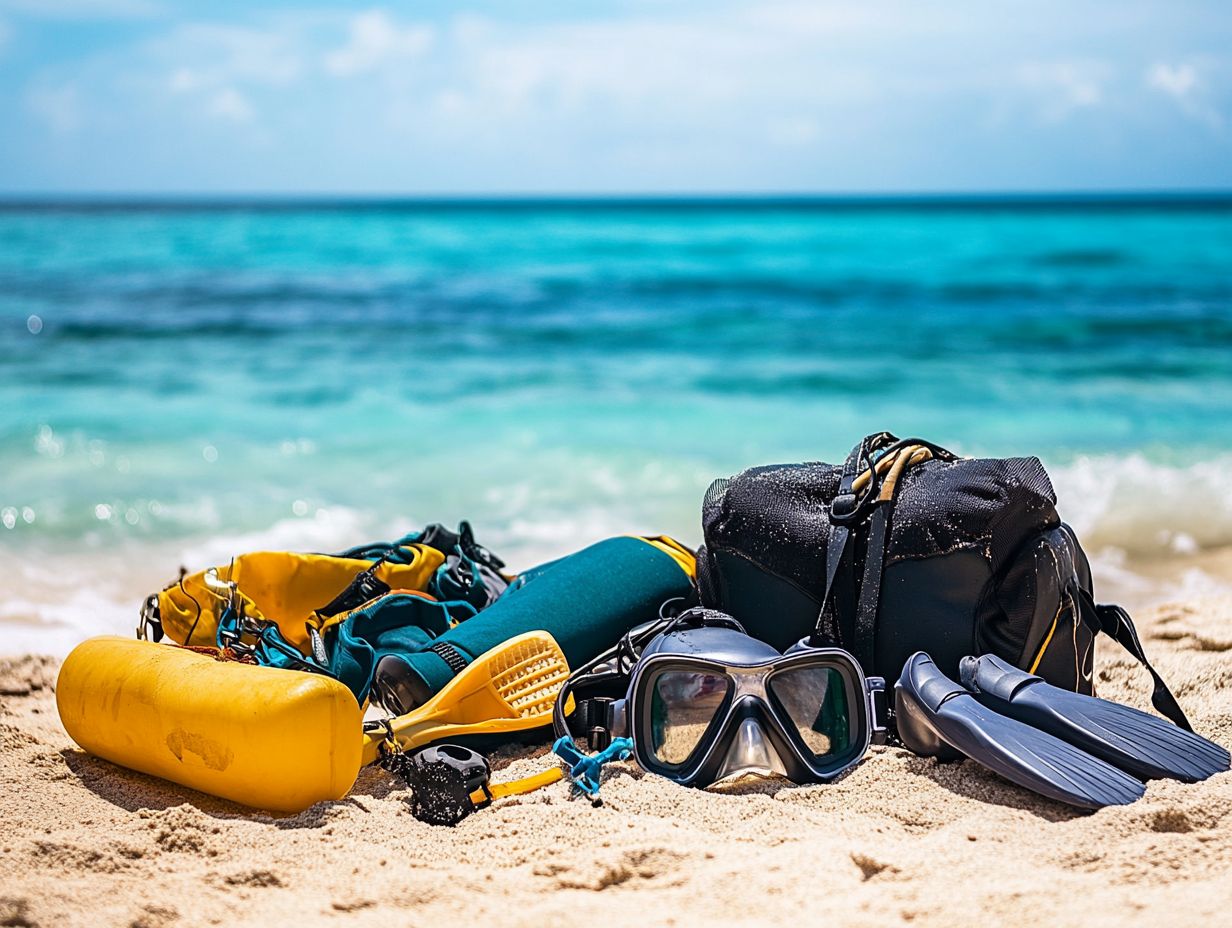
What is free diving?
Free diving is a water activity that involves diving underwater without the use of scuba gear or any artificial breathing apparatus.
What gear is needed for free diving?
You need a wetsuit, weight belt, dive mask, snorkel, fins, and weights for free diving. Optional items include a dive watch, a dive computer, and an underwater camera.
What is the purpose of a wetsuit in free diving?
A wetsuit keeps you warm in cold water and protects your body. It also helps you float better and reduces drag while you dive.
Do I need a weight belt for free diving?
Yes, a weight belt helps you stay underwater comfortably. The weight you need varies based on your body type and the thickness of your wetsuit.
Why is a dive mask important in free diving?
A dive mask lets you see clearly underwater by creating an air pocket for your eyes. It also shields your eyes from water pressure and debris.
What are the benefits of using a dive computer in free diving?
A dive computer tracks your depth and time underwater, ensuring your safety. Some models even provide real-time feedback on your heart rate and oxygen levels.

